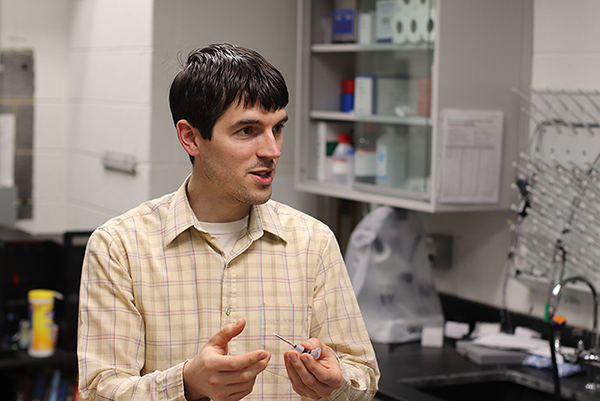
By Kathy Williams.
Even with the most advanced hardware and movement control technology, current prosthetic limbs still do not move and feel like a person’s biological limb. One main reason for this is that current prostheses are worn on the outside of the body and have limited direct contact or physical interaction with tissues responsible for biological movement and sensation.
Assistant Professor Dustin Crouch is working to move prosthetics inside.
Crouch, who runs the Upper Limb Assist Lab in MABE, has been collaborating with the UT College of Veterinary Medicine and UT Medical Center to develop technologies and treatments with the hope of revolutionizing how prostheses are worn and interact with the body.
Crouch’s research uses muscle-driven endoprostheses, a type of prosthetic that is completely implanted under the skin and physically attached to the residual muscles and bone, enabling patients to do things they can’t do with current prosthetics.
To help further his research, the National Institute of Arthritis and Musculoskeletal and Skin Disease (NIAMS), an institute at the National Institutes of Health (NIH)—the nation’s premier biomedical research agency—has awarded Crouch funding for the next two years. The project will be co-funded by the NIH National Center for Musculoskeletal Rehabilitation Research.
“The funding will support our long-term goal to develop limb prosthesis that can be completely implanted in the body so they can be physically attached to and controlled by muscles.” Crouch said. “We hope this will restore more natural control and sensation of movement to people with amputation.”
Crouch’s team is currently in the initial testing and design phase of the project.
“The function that a person has with an implanted, muscle-driven prosthesis will depend on many things,” said Crouch. “One of them is how well the muscle can recover after amputation and reattachment to the prothesis.”
With the NIAMS funding, Crouch will investigate the effects of the prothesis and the muscle reattachment timing on muscle recovery and limb function.
Crouch hopes that, in the near future, his research will make an impact in the lives of the more than 2 million people who have undergone an amputation or had a limb removed for medical reasons.